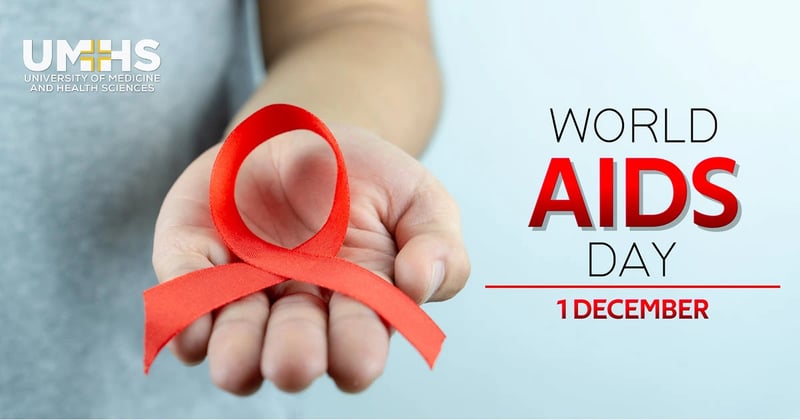Today is World AIDS Day, observed every year since 1988 on December 1st as a “day of solidarity, representing an opportunity for people worldwide who are affected by HIV (Human Immunodeficiency Virus) to share their stories and experiences, to remember those lost, and to highlight efforts on every front to end the HIV epidemic,” according to the CDC. This year’s theme is “Ending the HIV Epidemic: Equitable Access, Everyone’s Voice.”

(Inset, right): UMHS professor & virus expert Dr. Nichole Cumby. Photo courtesy of Dr. Cumby.
In observance of this important day, more than 40 years since the beginning of the HIV epidemic, the UMHS Endeavour spoke to UMHS professor Dr. Nichole Cumby, Assistant Professor of Microbiology and a noted expert on viruses. We spoke to Dr. Cumby about the promise of the new mRNA HIV vaccines, new therapeutic treatments like the once-monthly HIV injections, what the general public and med students should know about HIV, why it is still a problem (an estimated 37.7 million people globally were living with HIV at the end of 2020) and more.
Will we ever see an HIV vaccine?
There is a lot of promise with the new mRNA vaccine currently being developed to prevent HIV.
“The development of a vaccine for the Human Immunodeficiency Virus (HIV) has been one of the greatest challenges in vaccine development to date,” Dr. Cumby said. “The goal of vaccination is to develop a protective immune response ahead of exposure that can protect the patient once they are exposed to the real thing. One of the biggest issues with producing a vaccine against HIV is the high mutation rate of this virus. The virus’s replication enzyme, reverse transcriptase, is extremely error prone leading to between 1-10 new mutations to the virus every time it copies its genome. This means that HIV is changing during its infection allowing it to evade immune responses, including those made by vaccination.”
HIV has a high mutation rate, meaning there is genetic diversity in HIV viruses.
“First there are two groups of HIV virus: HIV-1 and HIV-2. HIV-1 is the prevalent strain worldwide but HIV-2 has started to be found more commonly. There are also four main groups of HIV-1 and nine different subgroups. A vaccine against HIV therefore needs to protect against all the various types and subtypes. In the past, scientists often got ideas for vaccine targets by examining successful immune responses produced by previously infected people who have resolved the infection and are now protected. However, in HIV infections, no one has been known to fight off and resolve the infection, thus there were no successful resolving immune responses to analyze either.”
Moderna, the company best known for its highly effective COVID-19 vaccine, is working on an HIV vaccine that uses similar mRNA technology.
“Moderna’s new mRNA vaccine is an interesting candidate that has recently entered into phase I testing,” Dr. Cumby said. “It uses the same mRNA platform as their COVID-19 vaccine. The mRNA platform has so far demonstrated itself as versatile, safe, easy to manufacture and immunogenic, so it definitely has a lot of potential for other applications. Additionally, Moderna is incorporating another interesting discovery into this new vaccine. Fairly recently, through extensive studies on individuals living with HIV, a potent type of antibody, known as a broadly neutralizing antibody was found in some patients. Broadly neutralizing antibodies are antibodies that target more conserved regions of a virus less prone to mutate. This potentially gives them the ability to bind and neutralize many different versions of the same virus, making them possibly ideal for dealing with the variability that exists in HIV. These types of antibodies have been found in patients but not until the later stages of infection. Unfortunately, by this time, they are no longer able to stop the infection from taking hold since HIV is able to become a permanent part of the human cell by entering into human DNA. Thus, the idea has arisen that maybe if this response can be induced before exposure to the HIV infection, a person might be able to neutralize the incoming virus and prevent it from ever becoming a permanent infection. So, the new mRNA vaccine in clinical trials is applying the utility of the mRNA platform to deliver sequences designed to elicit the production of these broadly neutralizing antibodies. Only time will tell if this approach will be successful, but it is combining a lot of promising new concepts that deserve full exploration.”
New monthly HIV therapeutics
HIV-positive people currently take a cocktail of different protease inhibitor drugs to keep the HIV virus in their system undetectable and therefore not cause any of the complications many might suffer without these life-saving medications.
A new once-monthly vaccine is making it possible for some to avoid taking daily pills.
“The new once-a-month HIV drug injection, Cabenuva, is a game changer with respect to HIV treatments. The current protocols for HIV involve taking daily pills that combine various antiretrovirals with the goal being to keep the viral load in patients as low as possible. Unfortunately, a cure for HIV still eludes scientists due to the nature of the virus. The current drugs are very effective in suppressing active viral replication but they are unable to eliminate HIV from the body as HIV is able to hide out inside of cells as a piece of DNA within the patient’s own genetic code. So, while the actively replicating virus can be suppressed, if the medications are stopped, the virus has the ability to come back and start replicating again from the hidden DNA. Until there is an effective way to deal with this, completely curing HIV will remain impossible.”
What are the benefits of a monthly injection for HIV+ people?
“While Cabenuva is no more effective than the current daily pill regimen in terms of treatment ability, it makes patient compliance at lot easier. Instead of having to take a daily pill, the patient can get their antiretrovirals drugs injected once a month and this is able to suppress their HIV the same way the daily pills would for a month. Cabenuva combines two drugs: Cabotegravir, which blocks the viral integrase, and Rilpivirine which inhibits the viral reverse transcriptase enzyme. It can potentially be used on patients currently on a stable regimen whose HIV has no history of resistance to the two drug classes used in Cabenuva. Like the daily pills, it still does not cure HIV. However, it makes it way easier for a patient to stay compliant with their medications. This is really important as HIV is very good at becoming resistant to drugs and it is easier for drug resistance to develop in people who miss doses of their treatments. Therefore, a once-a-month protocol is easier to adhere to for the patient, and as a result makes the patient’s life easier and helps prevent the development of drug resistance strains.”
Misconceptions about HIV & AIDS
Dr. Cumby said there are unfortunately still many common misconceptions about HIV and AIDS that still exist.
“One of the biggest ones is that HIV is only a problem within certain groups and communities. People either think of it as a ‘homosexual disease’ or a disease that is a problem only in remote places like Africa. This leads to many people thinking that HIV is not a danger for them. At the extreme end, this can lead to people not wanting to fund research into the disease and as well as the stigmatization of those currently suffering from HIV.
“What many fail to realize, is that this is untrue and HIV is a problem for everyone, everywhere. Long before the COVID-19 pandemic, we had already been experiencing a global pandemic for HIV. According to the World Health Organization, there are an estimated 37.7 million people living with HIV at the end of 2020. There were around 1.5 million new infections in 2020. To date HIV has claimed 36.3 million lives. This number includes people from all walks of life. HIV does not care about sexual orientation and it does not recognize a country’s borders. HIV is a blood-borne pathogen and can be spread by a variety of methods including: blood-to-blood contact like blood transfusions, contaminated needles, heterosexual sex, homosexual sex, breast feeding, and during birth. HIV is ultimately a human problem. Only by coming together and treating it as such can we truly devote the resources needed to ultimately find a cure.”
Hope for people with HIV
The public and medical community should understand the many advances made to help control the condition.
“An HIV diagnosis is no longer a death sentence, but rather a more manageable chronic condition. This means that people who are HIV+ can live long, productive lives. Viral levels can be made low enough with drugs that even the risk of transmission to an uninfected partner becomes negligible with good adherence to treatment. This does not mean that the end to this pandemic is not still an important goal for everyone involved, but it is important to acknowledge how far we’ve come for anyone who might receive this diagnosis of HIV positive in the future.”
(Top photo): More than 37.7 million people were living with HIV at the end of 2020. The promise of a possible vaccine & new monthly therapeutics offer hope on World AIDS Day 2021. A red ribbon (pictured) has become the universal symbol for AIDS & HIV awareness. Photo: Adobe stock image.

Scott is Director of Digital Content & Alumni Communications Liaison at UMHS and editor of the UMHS Endeavour blog. When he's not writing about UMHS students, faculty, events, public health, alumni and UMHS research, he writes and edits Broadway theater reviews for a website he publishes in New York City, StageZine.com.
















